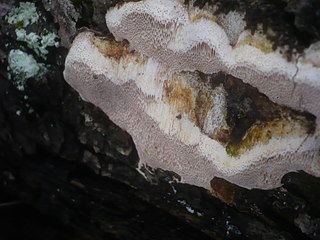Related Research Articles

The Polyporaceae are a family of poroid fungi belonging to the Basidiomycota. The flesh of their fruit bodies varies from soft to very tough. Most members of this family have their hymenium in vertical pores on the underside of the caps, but some of them have gills or gill-like structures. Many species are brackets, but others have a definite stipe – for example, Polyporus badius.

Perenniporia is a cosmopolitan genus of bracket-forming or crust-like polypores in the family Polyporaceae. They are dimitic or trimitic with smooth, thick-walled basidiospores and cause a white rot in affected wood.
Ceriporia xylostromatoides is a species of fungus in the family Irpicaceae. It is a plant pathogen.

Oxyporus is a genus of polypore fungi in the family Schizoporaceae. An individual family Oxyporaceae was described for the genus. A number of species in this genus are plant pathogens, causing a white rot. The genus is widely distributed.

Rigidoporus is a genus of fungi in the family Meripilaceae. Many of the species in this genus are plant pathogens. The widespread genus, which contains about forty species, was originally circumscribed by American mycologist William Alphonso Murrill in 1905. The generic name combines the Latin word rigidus ("rigid") with the Ancient Greek word πόρος ("pore").

The Meruliaceae are a family of fungi in the order Polyporales. According to a 2008 estimate, the family contains 47 genera and 420 species. As of April 2018, Index Fungorum accepts 645 species in the family.
Leif Randulff Ryvarden is a Norwegian mycologist.

Antrodiella is a genus of fungi in the family Steccherinaceae of the order Polyporales.
Humphreya is a genus of four species of polypore fungi in the family Ganodermataceae. The genus was circumscribed by Belgian mycologist René Léopold Steyaert in 1972. He proposed Humphreya as a genus segregate from Ganoderma, typified by Ganoderma lloydi Pat. & Har., and included Ganoderma coffeatum and the newly described Humphreya endertii. H. eminii was transferred to the genus by Leif Ryvarden in 1980.
Diacanthodes is a genus of three species of poroid fungi in the family Meruliaceae.

Coriolopsis is a genus of fungi in the family Polyporaceae. It was circumscribed by American mycologist William Alphonso Murrill in 1905. The genus is cosmopolitan, with most species in tropical areas. The generic name combines the name Coriolus with the Ancient Greek word ὄψις ("appearance").
Grammothele is a genus of poroid crust fungi in the family Polyporaceae.

Lignosus is a genus of polypore fungi in the family Polyporaceae. The genus was circumscribed in 1920 by mycologists Curtis Gates Lloyd and Camille Torrend, with L. sacer as the type species.
Macrohyporia is a genus of fungi in the family Polyporaceae. The genus was circumscribed by mycologists I. Johansen and Leif Ryvarden in 1979.
Navisporus is a genus of seven species of tropical poroid fungi in the family Polyporaceae. It was circumscribed by Norwegian mycologist Leif Ryvarden in 1980 with Navisporus floccosus as the type species. This fungus, first described as Trametes floccosa by Giacomo Bresadola in 1896, is thought to have been originally collected in Tanzania.

Nigroporus is a genus of poroid fungi in the family Steccherinaceae. The genus was circumscribed by American mycologist William Alphonso Murrill in 1905. Nigroporus has a pantropical distribution. The genus name combines the Latin word niger ("black") with the Ancient Greek word πόρος ("pore").
Pseudopiptoporus is a genus of fungi in the family Polyporaceae. It was circumscribed by Norwegian mycologist Leif Ryvarden in 1980 with the type species Pseudopiptoporus devians. This fungus was originally published as Polyporus devians by Giacomo Bresadola in 1920. Pseudopiptoporus chocolatus was added to the genus in 2003.

Skeletocutis is a genus of about 40 species of poroid fungi in the family Polyporaceae. The genus has a cosmopolitan distribution, although most species are found in the Northern Hemisphere. Skeletocutis causes a white rot in a diverse array of woody substrates. Their fruit bodies grow as a crust on the surface of the decaying wood. Sometimes the edges of the crust are turned outward to form rudimentary bracket-like caps.
Tinctoporellus is a genus of fungi in the family Polyporaceae. Species in the genus produce crust-like fruit bodies with pore-containing surfaces. The type species, T. epimiltinus, grows on the wood of angiosperms and is widespread in distribution. Tinctoporellus was circumscribed by Norwegian mycologist Leif Ryvarden in 1979. He suggested that Antrodia was closely related based on morphological similarities.
Hapalopilus albocitrinus is a species of polypore fungus. Found in South Asia and Africa, it was first described in 1922 by Thomas Petch as a species of Poria. Leif Ryvarden transferred it to the genus Hapalopilus in 1980.
References
- ↑ Johansen I, Ryvarden L. (1979). "Studies in the Aphyllophorales of Africa: VII. Some new genera and species in the Polyporaceae". Transactions of the British Mycological Society. 72 (2): 189–99. doi:10.1016/S0007-1536(79)80031-5.
| | This Agaricomycetes-related article is a stub. You can help Wikipedia by expanding it. |